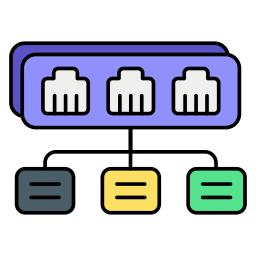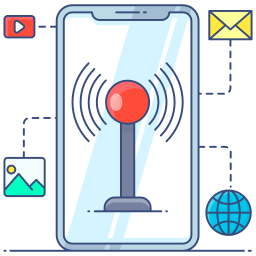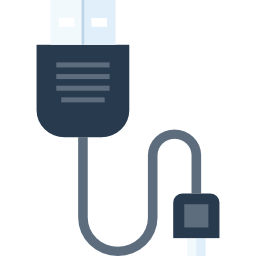
Hub

Hub and Network Hardware Components A hub is one of the most basic network hardware components used in computer networking. It operates at the physical layer (Layer 1) of the OSI model and serves as a central connecting device in a network. When a hub receives a data packet from one of its ports, it broadcasts the data to all other ports, regardless of the intended …
Read More
Access Point (AP)

Access Point (AP) and Network Hardware Components An Access Point (AP) is a fundamental network hardware device used to enable wireless connectivity within a wired network infrastructure. It serves as a bridge between wired Ethernet networks and wireless devices such as laptops, smartphones, tablets, and IoT devices. Access Points operate primarily at the data link layer (Layer 2) of the OSI model but also interact …
Read More
Switch

Switch and Network Hardware Components: A Comprehensive Overview Switches and other network hardware components form the backbone of any local area network (LAN) or larger network infrastructure. These physical devices are responsible for enabling communication between computers, servers, printers, and other devices within a network. They ensure data is transmitted efficiently, securely, and accurately across different endpoints. Network Switch A switch is a fundamental …
Read More
Router

Router and Network Hardware Components: A Comprehensive Overview A router is one of the most essential hardware components in a computer network. It functions as a traffic director, managing the flow of data between different networks and ensuring that information reaches its correct destination. Routers are used in both home and enterprise environments to connect multiple devices to the internet or to other networks. They …
Read More
Modem

Modem and Network Hardware Components: A Comprehensive Explanation A modem is a fundamental piece of network hardware that facilitates communication between a local network and the internet. The word “modem” comes from the combination of two words: modulator and demodulator. Its primary function is to convert digital data from a computer or network into analog signals suitable for transmission over telephone lines, cable systems, or …
Read More
Antenna

Antenna in Mobile Phone Hardware Components: Comprehensive Overview and Applications The antenna is a fundamental hardware component in mobile phones, playing a critical role in enabling wireless communication. It acts as a bridge between the mobile device and the surrounding network by transmitting and receiving radio frequency signals. Without the antenna, a mobile phone would be unable to connect to cellular networks, Wi-Fi, Bluetooth, or …
Read More
Sensors (Gyro, Light, etc.)

Mobile Phone Hardware Sensors and Their Applications Modern smartphones are equipped with a wide range of hardware sensors that enable various functions and enhance user experience. These sensors work in the background to provide data about the phone’s environment, motion, orientation, and proximity. Below is a detailed explanation of the most important hardware sensors found in mobile phones, their uses, and whether they are free …
Read More
PCB / Mainboard

PCB / Mainboard in Mobile Phones – Hardware Components and Their Functions The PCB (Printed Circuit Board), also known as the mainboard or motherboard, is the central hardware platform in any mobile phone. It is the core component that connects and holds together all other internal parts and manages communication between them. This board is carefully designed and engineered to ensure compactness, efficiency, and reliability …
Read More
Charging Port (USB-C/Lightning)

Charging Port (USB-C / Lightning) in Mobile Phones – Hardware Components and Their Functions The charging port is a fundamental hardware component in every mobile phone. It serves as the physical interface that allows power and data transfer between the smartphone and external devices. The two most common types of charging ports in modern smartphones are USB-C and Lightning. While they serve the same basic …
Read More
SIM Card Slot / Tray

SIM Card Slot / Tray in Mobile Phone Hardware Components The SIM card slot or tray is a vital hardware component found in virtually all modern mobile phones. It serves as the dedicated interface between the physical SIM card and the internal circuitry of the mobile device. While it may seem like a small and simple part of a phone, the SIM card slot plays …
Read More
Vibration Motor

Vibration Motor in Mobile Phone Hardware Components The vibration motor is a small but significant hardware component found in nearly all mobile phones. It is responsible for generating vibrations that serve as tactile feedback for various phone functions. Despite its compact size, the vibration motor contributes meaningfully to the user experience by providing non-visual, non-auditory cues through haptic feedback. It enhances usability, especially in situations …
Read More
Speaker

Speaker in Mobile Phone Hardware Components The speaker is a crucial hardware component integrated into mobile phones, responsible for converting electrical signals into audible sound. It plays a central role in a wide range of functions, from voice communication to media playback. As technology has evolved, the design, quality, and functionality of mobile phone speakers have significantly improved, allowing users to experience clearer and louder …
Read More
Microphone
Front Camera
Rear Camera

Hardware Tools
Microsoft Tools: Comprehensive Overview, Uses, and Comparison
Microsoft Tools encompass a wide range of software applications and services developed by Microsoft to enhance productivity, communication, creativity, and entertainment across personal, educational, and professional environments. These tools are designed to integrate seamlessly with the Windows operating system, offering a coherent ecosystem that supports diverse user needs. Microsoft Tools are widely recognized for their reliability, security, and compatibility with both desktop and cloud-based platforms, making them essential for individuals, organizations, and educational institutions.
One of the core uses of Microsoft Tools is productivity. Applications such as Word, Excel, and PowerPoint allow users to create, edit, and manage documents, spreadsheets, and presentations efficiently. Word provides advanced word processing capabilities, supporting text formatting, collaboration, and document sharing. Excel offers powerful data management and analysis functions, including formulas, pivot tables, and charts, which are widely used in finance, research, and business operations. PowerPoint enables the creation of professional presentations with multimedia integration, animation, and design templates, facilitating effective communication in corporate, academic, and personal contexts.
Collaboration and communication are also central to Microsoft Tools. Outlook serves as a comprehensive email client, calendar, and task manager, allowing users to manage schedules, organize meetings, and integrate communication across multiple devices. Teams is a hub for teamwork, combining chat, video conferencing, file sharing, and project management in one platform. OneNote provides a digital notebook environment for organizing notes, multimedia content, and research materials, enabling collaboration in educational and professional settings. These tools facilitate seamless interaction among individuals and groups, whether working in offices, remotely, or in classrooms.
Cloud storage and data management are supported through OneDrive, which allows users to store, sync, and share files securely. OneDrive integrates with Microsoft Office applications, enabling real-time collaboration and access to files from multiple devices. This cloud-based approach supports backup, remote work, and file recovery, making it an essential component of Microsoft’s ecosystem. For creative projects, Paint and Minecraft provide unique platforms for visual expression, digital art, and game-based learning. Paint offers a simple yet effective tool for image creation and editing, while Minecraft encourages creativity, problem-solving, and coding skills through interactive gameplay and educational editions.
Microsoft Store functions as a central hub for accessing applications, games, media content, and hardware. Users can browse, download, and purchase software, movies, and music with security and convenience. Xbox integration and subscription services such as Game Pass provide gaming experiences and access to a library of titles across devices. Phone Link allows seamless connection between Windows PCs and smartphones, enabling users to access notifications, messages, and apps from their mobile devices directly on a computer. Passkey enhances digital security by offering a modern authentication method that reduces reliance on traditional passwords.
Regarding cost, Microsoft Tools offer a combination of free and paid options. Many applications, such as Word, Excel, PowerPoint, and OneNote, are accessible through free versions or limited functionality modes, while premium features, additional storage, or enterprise capabilities require subscription or purchase. Microsoft 365, for example, bundles popular applications and services with cloud storage for a monthly or yearly fee. Minecraft, Xbox Game Pass, and premium apps from Microsoft Store typically require purchase or subscription, although trial versions or limited free content are often available. Compared to third-party alternatives, Microsoft Tools provide stronger integration, security, and support but may involve higher costs for advanced features or bundled services.
When compared to other productivity and creative ecosystems, Microsoft Tools excel in integration and versatility. Competing platforms such as Google Workspace, Apple iWork, or independent software may offer similar features in isolated areas, but Microsoft’s suite provides a unified experience across desktop and cloud environments. The ability to collaborate in real-time, access files from multiple devices, and leverage enterprise-grade security makes Microsoft Tools particularly attractive for business, educational, and professional use. Moreover, the extensive support network, regular updates, and continuous innovation reinforce their reliability and long-term value.
In conclusion, Microsoft Tools form a comprehensive ecosystem that supports productivity, communication, creativity, education, and entertainment. Their applications range from essential office software to cloud storage, gaming, security, and collaboration platforms, all designed to work seamlessly together. While some features require payment, the combination of free access, subscription options, and cross-device integration ensures that Microsoft Tools provide exceptional value to individual users, organizations, and educational institutions. The ecosystem’s strengths lie in its versatility, security, and cohesive design, allowing users to manage tasks, projects, communication, and digital content efficiently. Overall, Microsoft Tools are not only practical solutions for daily tasks but also strategic platforms that enhance creativity, learning, and professional development, making them a cornerstone of modern digital life.


Google Drive
لورم ایپسوم متن ساختگی با تولید سادگی نامفهوم از صنعت چاپ و با استفاده از طراحان گرافیک است.
★★★★★


Google Scholar
لورم ایپسوم متن ساختگی با تولید سادگی نامفهوم از صنعت چاپ و با استفاده از طراحان گرافیک است.
★★★★★


Google Trends
لورم ایپسوم متن ساختگی با تولید سادگی نامفهوم از صنعت چاپ و با استفاده از طراحان گرافیک است.
★★★★★
سبد خرید


















